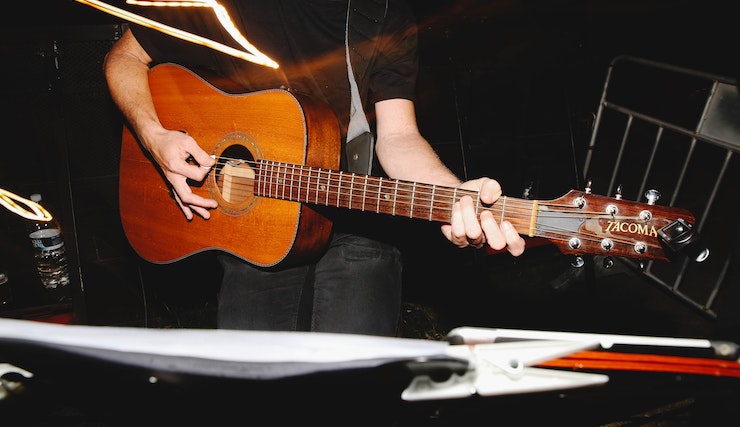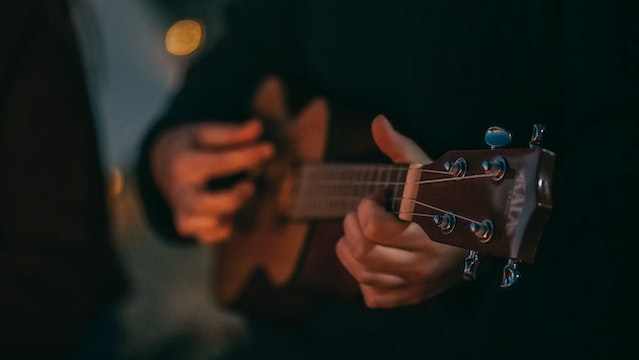What Does B Mean In Guitar Tabs?
In tabs for guitar, the “b” in guitar tabs stands for a bend. When you encounter a “b” in a guitar tab, you must bend the string to alter the pitch. This bend is done differently based on the tab’s notation or the style of the music that’s being played.
For bending, it is common to place your hand on the string at the appropriate fret, then use your wrist or another finger to push the string upwards or down in a different pitch direction. The exact pitch at which you need to bend your string is typically specified in the tab, like a half step (one fret) or a full step (two frets), as well as more. It is possible to bend the string by a certain amount. You can be different based on the setting and the tone you’re trying to achieve.
Bends are an essential skill when playing guitar, which allows you to add more expressiveness and emotion to your song. They are frequently used in riffs, solos, and melodies to produce melodic variations and mimic vocal effects. The precise execution of bends can affect a song’s overall tone and feel. Therefore, it’s essential to learn and gain control over the bending technique you use.
If you notice the “b” in a guitar tab, you should bend the string “b” in a guitar tab, which means you must bend the string to produce changes in the pitch. Making and incorporating a few bends into your playing will significantly improve your guitar playing and musicality.
What Does The letter B Mean On The Guitar?

Bend
In guitar tabs, the “b” on the tabs represents a bend. You must bend the string to alter its pitch if you come across the letter “b” in a guitar tab. It is a method where you physically pull or push the string to increase or decrease its pitch while keeping a connection with the fret.
Execution of a Bend
When you want to bend the string, you typically put your hand on the string on the designated fret and then use a different wrist or finger to push the string upwards or down to a different pitch. The exact pitch at which you need to bend your string is usually listed in the tab, for example, half step (one fret), full step (two frets), or further.
Amount of Bend
The amount of bend needed will vary based on the situation and the desired sound. Guitar tabs might indicate the precise pitch at which the string will be bent. They could provide general instructions, for example, “bend up,” leaving the exact interpretation of pitch to the musician. It is important to pay attention to the source of your music or to follow the style of music you’re playing to determine the right extent of the bend.
Expression and musicality
Bends are a key technique for the guitar that allows you to add a sense of emotion and expression to your songs. They are often employed in riffs, solos, and melodies to create musical variations and mimic vocal effects. If you can master bending techniques, it is possible to infuse your playing with subtleties and dynamic shifts, increasing the quality of your playing.
Control and Practice
Controlling bends and bending with accuracy require a lot of practice. Strengthening your fingers and coordinating is vital to ensuring smooth, controlled bends. You’ll need to build pitch awareness to precisely hit the note you want to hit when you bend. Try bending both upwards and downwards until you are familiar with methods of bending and how to achieve consistent, well-controlled bends.
In essence, the “b” in guitar tabs is a sign of a bend “B” in guitar tabs refers to a bend. It involves physically pulling or pushing strings to alter their pitch. Bends let you bring emotion, expression, and variety to your play. A bend’s amount can differ, and a lot of practice and mastering the bending technique are crucial to bending accurately and consistently.
Does B Mean Flat Guitar?

Yes, it is true that “B” is a letter “B” in guitar notation that could represent the note B when followed by the lowercase “b,” indicating a flat. This is a thorough explanation that includes separate headnotes (h3) for each of the points:
B is “B flat”
In music theory and notation, “B” is the letter in notation, and the musical “B” represents the musical note B. If it is the case that the word “B” is followed by the lowercase “b” (Bb), it signifies flat. A flat reduces notes’ pitch by a half step. In the guitar notation, “Bb” indicates the note B flat in particular.
Guitar Tuning
In the normal tuning for guitar, the open strings have tunings of A, E, D, G, B, and E, ranging from low to high. The second-highest string, tuned according to note B, is an unnatural B. If you find a tab for guitar or a chord chart with “Bb” in it, you need to change the letter “Bb” in it; it is a sign that you should use the flat B note rather than the natural B in the string.
Chords and Scales
When making scales or chords in which the Bb flat (Bb) changes the tonality in the musical. For instance, a flat B major chord would comprise the notes D, Bb, and F, while the B major chord would comprise three notes: B# and F#. In scales such as B flat (Bb), the note is used instead of the natural B note in scales like B flat minor or B major.
Transposition and Key Signatures
The presence of Bb (Bb) in the key signature of a song or a particular piece of music indicates that all B notes in the composition are designed to be played in B flat. It influences the overall tone and chords used throughout the work. Key signatures for B flat typically comprise F major, B flat major, and their respective minor keys.
In the end, in guitar notation, “Bb” denotes the B flat note, whereas “B” typically represents the natural B note. A B flat note changes the tone of scales, chords, and compositions for music. Knowing the difference between B flat and B is vital to accurately reading guitar tabs, chord charts, and musical notation.
What Is The Key Of The Guitar Of B?

The B key in guitar is the musical key centered around the note B. This is a comprehensive explanation, with distinct heads (h3) for each occurrence:
The Key of B
The B key is a key that is major in the field of music theory. It is identified by the letter B and is built upon the B major scale. If you play in the B key on the guitar, note B is the key’s tonic or “home” note. The key major comprises notes B, C#, D#, F#, E, G#, and A#.
Guitar Chords in the Key of B
Various chords form melodies or progressions if you play in the B key on the guitar. The principal chords that are naturally found in the B major key include B major (B), E major (E), and F# major (F#). According to this, these chords are often employed as the tonic, dominant, and subdominant chords. Furthermore, other chords derived from the B major scale, such as the B major scale, including B minor (Cm) and G diminished (G dim), could be used to add the dime and diversity of chord progressions in the major key B.
Guitar Scales in the Key of B
If you play in the key of B on the guitar, this scale, known as B Major, is considered the most fundamental scale used. It is the B-major scale. It is based on a certain sequence of full stages (W) and half steps (H). The scale comprises the nots: B, C#, D#, EF#, F#, G#, and#. If you can master and practice this major scale on your guitar fretboard, you can play and create melodies in B’s key. B.
Transposition and Capo Use
It’s important to remember and note that the B key on the guitar is a challenge for certain players due to the fingers and the location of the fretboard’s chords. In the end, guitarists can choose to transpose their song or utilize a capo to ease playing in the B key. Transposition is changing the whole song’s key to a comfortable one, while caps let you keep the same chord forms but alter the key by putting the capo on the opposite fret.
In short, the B key in guitar is founded on the scale B major, which uses chords and scales around the B note. The most frequently used chords in the B major key comprise B, E, and F#. In addition, the B major scale serves as the foundation for melodic improvisation in B. Using transposition or capos can benefit those who find playing within the keys of B difficult. Knowing how to play the keys of B can help guitarists compose, play, and solo in this particular musical key.
What Is The Best Way To Play B-Tab Guitar?

B Chord Tab Notation
It is typically played as a barre on the guitar. The tab note of the chord B is:
e|—2—|
B|—4—|
G|—4—|
D|—4—|
A|—2—|
E|——-|
Finger Placement
For playing the B note, you’ll have to use the index fingers to hold the second fret over all strings. That means you’ll simultaneously press down on all strings using the index fingers. Be sure to apply enough pressure to create the clearest sound from each.
Additional Fingers
In addition to securing the second fret of your guitar, you’ll be required to place your other fingers to make the remainder of the chord’s shape. Put your second finger on the third fret of B’s string. Place your 3rd finger on the 4th fret of the G string and your 4th finger on the 4th fret of the D string.
Muting Unwanted Strings
When you play chord B, you must remember to turn off your high-E string (the thinnest string) with the fleshy side of the finger. This will keep it from ringing and affecting the chord’s tone. Make sure not to play the lowest E string (the longest string) using your index finger, and it should be kept open and free of frets.
Strumming
When your fingers are aligned and in the right position, strum each string, beginning with string A (the 5th string) until the E string’s high end (the initial string). Ensure you don’t strum on the lower E string, which should be left open and not squeezed down.
Practice and Precision
The B chord can be difficult for novices because of the barre technique and the required finger strength. It’s essential to practice regularly and develop the strength and skill of your fingers. Begin by rubbing the second fret over all strings, then make sure each string has a clear sound. Adjust the position of your fingers and maintain the pressure until you can get a clear sound from every string.
In short, B chords on the guitar are often played as a barre. To play the chord, you must bar the second fret using your index finger. You then put your other fingers on the 4th fret on the G, B, and D strings. Shut off your high E string using your index finger, then strum all the strings downward, starting from the A string downward. Practice frequently to increase your power and control while playing chord B.
FAQ’s
What does “B” mean in a single letter guitar tab?
In a single letter guitar tab, “B” typically represents the open string note on the second (B) string of the guitar, which is tuned to the pitch of B.
What does “B” mean in a chord diagram?
In a chord diagram, “B” often represents the B major chord. The diagram shows the finger positions on the fretboard to play the B major chord shape.
What does “B” mean as a fret number in a tab?
When “B” appears as a fret number in a tab, it indicates that you should play a note on the second (B) string at that specific fret. For example, “2 on the B string” means you should play the note located on the second fret of the B string.
What does “B” mean as a barre chord?
“B” can represent a barre chord shape where you use your index finger to press down multiple strings across a specific fret. For instance, the B minor barre chord shape is commonly played by barring all the strings at the second fret with the index finger.
What does “B” mean as a power chord?
In power chords, “B” indicates the root note of the power chord. By placing your index finger on the second fret of the A string and your ring finger on the fourth fret of the D and G strings, you can form a B power chord.
What does “B” mean in guitar tab notation in relation to palm muting?
In guitar tab notation, “B” above or below a note indicates that you should palm mute that note. Palm muting involves lightly resting the edge of your picking hand near the bridge to produce a muted and percussive sound while playing the note.
What Does B Mean In Guitar Tabs?
In tabs for guitar, the “b” in guitar tabs stands for a bend. When you encounter a “b” in a guitar tab, you must bend the string to alter the pitch. This bend is done differently based on the tab’s notation or the style of the music that’s being played.
For bending, it is common to place your hand on the string at the appropriate fret, then use your wrist or another finger to push the string upwards or down in a different pitch direction. The exact pitch at which you need to bend your string is typically specified in the tab, like a half step (one fret) or a full step (two frets), as well as more. It is possible to bend the string by a certain amount. You can be different based on the setting and the tone you’re trying to achieve.
Bends are an essential skill when playing guitar, which allows you to add more expressiveness and emotion to your song. They are frequently used in riffs, solos, and melodies to produce melodic variations and mimic vocal effects. The precise execution of bends can affect a song’s overall tone and feel. Therefore, it’s essential to learn and gain control over the bending technique you use.
If you notice the “b” in a guitar tab, you should bend the string “b” in a guitar tab, which means you must bend the string to produce changes in the pitch. Making and incorporating a few bends into your playing will significantly improve your guitar playing and musicality.
What Does The letter B Mean On The Guitar?

Bend
In guitar tabs, the “b” on the tabs represents a bend. You must bend the string to alter its pitch if you come across the letter “b” in a guitar tab. It is a method where you physically pull or push the string to increase or decrease its pitch while keeping a connection with the fret.
Execution of a Bend
When you want to bend the string, you typically put your hand on the string on the designated fret and then use a different wrist or finger to push the string upwards or down to a different pitch. The exact pitch at which you need to bend your string is usually listed in the tab, for example, half step (one fret), full step (two frets), or further.
Amount of Bend
The amount of bend needed will vary based on the situation and the desired sound. Guitar tabs might indicate the precise pitch at which the string will be bent. They could provide general instructions, for example, “bend up,” leaving the exact interpretation of pitch to the musician. It is important to pay attention to the source of your music or to follow the style of music you’re playing to determine the right extent of the bend.
Expression and musicality
Bends are a key technique for the guitar that allows you to add a sense of emotion and expression to your songs. They are often employed in riffs, solos, and melodies to create musical variations and mimic vocal effects. If you can master bending techniques, it is possible to infuse your playing with subtleties and dynamic shifts, increasing the quality of your playing.
Control and Practice
Controlling bends and bending with accuracy require a lot of practice. Strengthening your fingers and coordinating is vital to ensuring smooth, controlled bends. You’ll need to build pitch awareness to precisely hit the note you want to hit when you bend. Try bending both upwards and downwards until you are familiar with methods of bending and how to achieve consistent, well-controlled bends.
In essence, the “b” in guitar tabs is a sign of a bend “B” in guitar tabs refers to a bend. It involves physically pulling or pushing strings to alter their pitch. Bends let you bring emotion, expression, and variety to your play. A bend’s amount can differ, and a lot of practice and mastering the bending technique are crucial to bending accurately and consistently.
Does B Mean Flat Guitar?

Yes, it is true that “B” is a letter “B” in guitar notation that could represent the note B when followed by the lowercase “b,” indicating a flat. This is a thorough explanation that includes separate headnotes (h3) for each of the points:
B is “B flat”
In music theory and notation, “B” is the letter in notation, and the musical “B” represents the musical note B. If it is the case that the word “B” is followed by the lowercase “b” (Bb), it signifies flat. A flat reduces notes’ pitch by a half step. In the guitar notation, “Bb” indicates the note B flat in particular.
Guitar Tuning
In the normal tuning for guitar, the open strings have tunings of A, E, D, G, B, and E, ranging from low to high. The second-highest string, tuned according to note B, is an unnatural B. If you find a tab for guitar or a chord chart with “Bb” in it, you need to change the letter “Bb” in it; it is a sign that you should use the flat B note rather than the natural B in the string.
Chords and Scales
When making scales or chords in which the Bb flat (Bb) changes the tonality in the musical. For instance, a flat B major chord would comprise the notes D, Bb, and F, while the B major chord would comprise three notes: B# and F#. In scales such as B flat (Bb), the note is used instead of the natural B note in scales like B flat minor or B major.
Transposition and Key Signatures
The presence of Bb (Bb) in the key signature of a song or a particular piece of music indicates that all B notes in the composition are designed to be played in B flat. It influences the overall tone and chords used throughout the work. Key signatures for B flat typically comprise F major, B flat major, and their respective minor keys.
In the end, in guitar notation, “Bb” denotes the B flat note, whereas “B” typically represents the natural B note. A B flat note changes the tone of scales, chords, and compositions for music. Knowing the difference between B flat and B is vital to accurately reading guitar tabs, chord charts, and musical notation.
What Is The Key Of The Guitar Of B?

The B key in guitar is the musical key centered around the note B. This is a comprehensive explanation, with distinct heads (h3) for each occurrence:
The Key of B
The B key is a key that is major in the field of music theory. It is identified by the letter B and is built upon the B major scale. If you play in the B key on the guitar, note B is the key’s tonic or “home” note. The key major comprises notes B, C#, D#, F#, E, G#, and A#.
Guitar Chords in the Key of B
Various chords form melodies or progressions if you play in the B key on the guitar. The principal chords that are naturally found in the B major key include B major (B), E major (E), and F# major (F#). According to this, these chords are often employed as the tonic, dominant, and subdominant chords. Furthermore, other chords derived from the B major scale, such as the B major scale, including B minor (Cm) and G diminished (G dim), could be used to add the dime and diversity of chord progressions in the major key B.
Guitar Scales in the Key of B
If you play in the key of B on the guitar, this scale, known as B Major, is considered the most fundamental scale used. It is the B-major scale. It is based on a certain sequence of full stages (W) and half steps (H). The scale comprises the nots: B, C#, D#, EF#, F#, G#, and#. If you can master and practice this major scale on your guitar fretboard, you can play and create melodies in B’s key. B.
Transposition and Capo Use
It’s important to remember and note that the B key on the guitar is a challenge for certain players due to the fingers and the location of the fretboard’s chords. In the end, guitarists can choose to transpose their song or utilize a capo to ease playing in the B key. Transposition is changing the whole song’s key to a comfortable one, while caps let you keep the same chord forms but alter the key by putting the capo on the opposite fret.
In short, the B key in guitar is founded on the scale B major, which uses chords and scales around the B note. The most frequently used chords in the B major key comprise B, E, and F#. In addition, the B major scale serves as the foundation for melodic improvisation in B. Using transposition or capos can benefit those who find playing within the keys of B difficult. Knowing how to play the keys of B can help guitarists compose, play, and solo in this particular musical key.
What Is The Best Way To Play B-Tab Guitar?

B Chord Tab Notation
It is typically played as a barre on the guitar. The tab note of the chord B is:
e|—2—|
B|—4—|
G|—4—|
D|—4—|
A|—2—|
E|——-|
Finger Placement
For playing the B note, you’ll have to use the index fingers to hold the second fret over all strings. That means you’ll simultaneously press down on all strings using the index fingers. Be sure to apply enough pressure to create the clearest sound from each.
Additional Fingers
In addition to securing the second fret of your guitar, you’ll be required to place your other fingers to make the remainder of the chord’s shape. Put your second finger on the third fret of B’s string. Place your 3rd finger on the 4th fret of the G string and your 4th finger on the 4th fret of the D string.
Muting Unwanted Strings
When you play chord B, you must remember to turn off your high-E string (the thinnest string) with the fleshy side of the finger. This will keep it from ringing and affecting the chord’s tone. Make sure not to play the lowest E string (the longest string) using your index finger, and it should be kept open and free of frets.
Strumming
When your fingers are aligned and in the right position, strum each string, beginning with string A (the 5th string) until the E string’s high end (the initial string). Ensure you don’t strum on the lower E string, which should be left open and not squeezed down.
Practice and Precision
The B chord can be difficult for novices because of the barre technique and the required finger strength. It’s essential to practice regularly and develop the strength and skill of your fingers. Begin by rubbing the second fret over all strings, then make sure each string has a clear sound. Adjust the position of your fingers and maintain the pressure until you can get a clear sound from every string.
In short, B chords on the guitar are often played as a barre. To play the chord, you must bar the second fret using your index finger. You then put your other fingers on the 4th fret on the G, B, and D strings. Shut off your high E string using your index finger, then strum all the strings downward, starting from the A string downward. Practice frequently to increase your power and control while playing chord B.
FAQ’s
What does “B” mean in a single letter guitar tab?
In a single letter guitar tab, “B” typically represents the open string note on the second (B) string of the guitar, which is tuned to the pitch of B.
What does “B” mean in a chord diagram?
In a chord diagram, “B” often represents the B major chord. The diagram shows the finger positions on the fretboard to play the B major chord shape.
What does “B” mean as a fret number in a tab?
When “B” appears as a fret number in a tab, it indicates that you should play a note on the second (B) string at that specific fret. For example, “2 on the B string” means you should play the note located on the second fret of the B string.
What does “B” mean as a barre chord?
“B” can represent a barre chord shape where you use your index finger to press down multiple strings across a specific fret. For instance, the B minor barre chord shape is commonly played by barring all the strings at the second fret with the index finger.
What does “B” mean as a power chord?
In power chords, “B” indicates the root note of the power chord. By placing your index finger on the second fret of the A string and your ring finger on the fourth fret of the D and G strings, you can form a B power chord.
What does “B” mean in guitar tab notation in relation to palm muting?
In guitar tab notation, “B” above or below a note indicates that you should palm mute that note. Palm muting involves lightly resting the edge of your picking hand near the bridge to produce a muted and percussive sound while playing the note.













